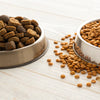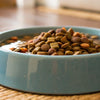Can I Feed My Dog Both Wet and Dry Food? Exploring the Benefits of Mixing
- Houndsy
Table of Contents
- Introduction
- Understanding the Basics: Wet vs. Dry Dog Food
- The Advantages of Mixing Wet and Dry Dog Food
- Considerations When Mixing Wet and Dry Dog Food
- Tips for Mixing Wet and Dry Dog Food
- The Houndsy Kibble Dispenser: Elevating Your Dog's Feeding Experience
- Conclusion
Introduction
Did you know that nearly 60% of dog owners mix wet and dry food to enhance their pet's dining experience? If you're a dog parent, you've probably pondered the question: Can I feed my dog both wet and dry food? This topic has gained traction as more pet owners seek to provide their furry companions with a balanced, enjoyable diet.
Feeding our dogs is more than just a necessity; it’s a ritual that can enrich their lives and strengthen our bond with them. Each type of dog food—wet and dry—comes with its own unique set of benefits. This blog post aims to explore the ins and outs of mixing these two food types, helping you make an informed decision for your pup's dietary needs.
By the end of this article, you’ll have a clear understanding of the advantages and disadvantages of feeding wet and dry food together, the nutritional implications, and how to do it effectively. We invite you to reflect on your own feeding routine and consider whether mixing might be a beneficial option for your dog.
Let’s dive into the details!
Understanding the Basics: Wet vs. Dry Dog Food
What is Dry Dog Food?
Dry dog food, commonly known as kibble, is a staple in many households due to its convenience and long shelf life. Typically made by cooking and then dehydrating meat, grains, and vegetables, dry kibble usually contains about 10-12% moisture. This makes it easy to store and serve. The nutritional formulation often includes vital vitamins and minerals, and many brands even incorporate probiotics to support digestive health.
Key Benefits of Dry Dog Food:
- Convenience: Easy to store and serve, with no need for refrigeration.
- Dental Health: Chewing kibble can help reduce plaque buildup and promote oral health.
- Cost-Effective: Generally less expensive compared to wet food.
- Long Shelf Life: Once opened, dry food remains fresh for an extended period.
What is Wet Dog Food?
Wet dog food, on the other hand, is typically sold in cans or pouches and contains a higher moisture content—usually 75-78%. This makes it an appealing option for dogs who may not be drinking enough water. Wet food often comes in various textures, including pâtés and chunks in gravy, making it enticing for even the pickiest eaters.
Key Benefits of Wet Dog Food:
- Hydration: The high moisture content supports hydration, especially crucial for dogs with certain health issues.
- Palatability: Often more aromatic and flavorful, which can entice dogs to eat, particularly useful for those with reduced appetites.
- Easier to Chew: Beneficial for senior dogs or those with dental issues, as it requires less chewing.
The Advantages of Mixing Wet and Dry Dog Food
1. Nutritional Balance
Mixing wet and dry food can provide a more balanced diet. While dry kibble often contains essential nutrients, wet food can enhance hydration and flavor. This combination ensures your dog receives all the necessary vitamins and minerals while enjoying a varied diet.
2. Increased Palatability
If you have a picky eater, mixing wet food with dry kibble can make meals more enticing. The moisture and aroma of wet food can coax even the most finicky dogs into finishing their bowl. This strategy may help alleviate concerns about your dog not eating enough.
3. Enhanced Hydration
For dogs that don’t drink enough water, incorporating wet food into their diet can help ensure they stay hydrated. This is particularly beneficial for dogs prone to urinary issues or kidney problems.
4. Variety in Diet
Just like us, dogs can get bored with the same meals every day. Mixing wet and dry food introduces variety in taste and texture, making mealtime more exciting for your furry friend.
5. Cost Efficiency
While wet food can be more expensive, using it as a topper for dry kibble can reduce the amount of wet food needed, thus lowering overall costs while still offering the benefits of both types.
Considerations When Mixing Wet and Dry Dog Food
1. Nutritional Needs
Before you start mixing, it’s crucial to understand your dog’s specific nutritional needs. Age, weight, activity level, and health conditions all play a role in determining how much food your dog should consume. Consulting with a veterinarian can help you create the right balance.
2. Proper Proportions
Generally, a good rule of thumb is to make dry food about 75% of the meal and wet food 25%. However, this ratio can vary based on your dog's individual needs and preferences. Adjusting the proportions can help manage your dog’s weight and ensure they receive adequate nutrition.
3. Storage and Freshness
When mixing wet and dry food, proper storage is essential. Wet food needs to be refrigerated after opening, while dry food can be stored at room temperature. Be sure to monitor the freshness of both types to prevent spoilage.
4. Transitioning to Mixed Feeding
If you decide to mix wet and dry food, do so gradually. Start by adding a small amount of wet food to the kibble and increase it over time. This helps your dog adjust to the new diet without stomach upset.
Tips for Mixing Wet and Dry Dog Food
- Choose Quality Products: Always opt for high-quality brands that meet AAFCO standards. Look for products that list meat as the first ingredient and avoid those with artificial additives.
- Monitor Your Dog’s Weight: Keep an eye on your dog’s weight and body condition. Adjust the portions as needed to prevent obesity or underfeeding.
- Stay Consistent: Once you've established a routine, try to maintain consistency in the types of food you mix. Frequent changes can lead to digestive issues.
- Consult Your Veterinarian: If your dog has special dietary needs, such as allergies or medical conditions, always consult your veterinarian before making changes to their diet.
The Houndsy Kibble Dispenser: Elevating Your Dog's Feeding Experience
At Houndsy, we understand the importance of a seamless and beautiful feeding experience for our beloved dogs. Our flagship product, the Houndsy Kibble Dispenser, is designed to simplify the feeding ritual. With features like a convenient crank at standing height, perfect portion control, and a stunning mid-century modern design, our dispenser enhances both the functionality of feeding and complements your home decor.
The Houndsy Kibble Dispenser holds a substantial 25-30 lbs of kibble, ensuring that your dog’s meals are consistent and fresh, thanks to a BPA-free liner. Plus, its auto-locking mechanism prevents accidental dispensing, making it a safe choice for curious pets or toddlers. Explore more about how the Houndsy Kibble Dispenser can transform your dog’s feeding routine here.
Conclusion
Mixing wet and dry dog food can be a wonderful way to provide your dog with a balanced, enjoyable diet. With the right knowledge and understanding of your dog’s nutritional needs, you can create mealtime experiences that are not only healthy but also exciting for your furry friend.
Whether you're looking to enhance hydration, improve palatability, or simply add variety to your dog’s meals, the key is to find the right balance. As we continue to strive for excellence in pet care, let’s embrace the joys of feeding our dogs with love and intention.
FAQ
Q: Is it safe to mix wet and dry dog food? A: Yes, mixing wet and dry dog food is safe as long as both types are high-quality and nutritionally balanced.
Q: How much wet food should I mix with dry food? A: A common ratio is about 75% dry food and 25% wet food, but this can vary based on your dog's specific needs.
Q: Can mixing wet and dry food improve my dog's appetite? A: Yes, the aroma and texture of wet food can make meals more enticing for picky eaters.
Q: How should I store wet food after opening? A: Wet food should be refrigerated and consumed within a few days after opening to maintain freshness.
Q: What are some signs my dog might need a different diet? A: Signs include changes in appetite, weight loss or gain, digestive issues, or decreased energy levels. Consult your veterinarian for guidance.
As you consider the best approach to your dog's diet, don’t forget to check out the Houndsy Kibble Dispenser for a convenient and stylish feeding solution. Transform your pet's feeding experience today! Order Now.












